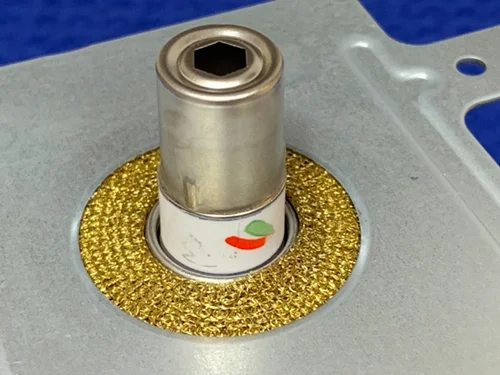In this comprehensive guide, we’ll explore the causes of microwave overheating, recognize the signs, and provide you with practical solutions to fix the problem. We’ll also discuss preventive measures to keep your microwave functioning efficiently.
Signs of Microwave Overheating
Recognizing the signs of microwave overheating is essential for timely intervention. Look out for these indicators:
- Burnt or Overcooked Food: If your food frequently comes out overcooked or burnt, it may be a sign of overheating. This can be both frustrating and a waste of food.
- Unusual Noises and Odors: Overheating can produce unusual noises and odors, such as a buzzing sound or a burning smell. These are clear signs that something is amiss.
- Excessive Steam or Smoke: If you notice an unusual amount of steam or even smoke escaping from your microwave during cooking, it’s a sign that it’s overheating.
Common Causes of Microwave Overheating
Understanding the causes of microwave overheating is essential for effectively addressing the issue. Microwave overheating can not only compromise the quality of your food but also pose safety risks. Let’s delve deeper into the common culprits behind this problem, including the symptoms, diagnostic measures, and descriptions:
1. Overcooking and Incorrect Settings
- Symptoms: Overcooked or burnt food, strong burning smell, unusual noises.
- Description: Overcooking or using the wrong power level can lead to excessive heat, causing food to burn and emit a strong, unpleasant odor. Unusual noises, such as crackling or popping, may also be heard during the process.
2. Blocked Ventilation:
- Symptoms: Excessive steam or smoke escaping from the microwave, burning odors during cooking.
- Description: When the microwave’s ventilation is blocked by food particles or debris, it cannot effectively release steam and heat. This leads to excessive steam escaping from the microwave, often accompanied by a burning odor.
3. Malfunctioning Components:

- Symptoms: Unusual noises, sparks, erratic heating, overheating regardless of settings.
- Description: A malfunctioning magnetron or thermostat can result in unusual sounds, sparks inside the microwave, inconsistent heating, and overheating, even when using appropriate settings.
4. Microwave Placement and Environment:
- Symptoms: Consistent overheating in a confined space, especially in a hot and poorly ventilated kitchen.
- Description: Placing the microwave in a confined space with limited air circulation or in a high-temperature environment can cause it to struggle with excess heat. This may result in consistent overheating issues.
Troubleshooting and Solutions
Microwave overheating can be a concerning issue, but there are practical steps you can take to troubleshoot and resolve this problem effectively. Here’s a detailed breakdown of these troubleshooting and solution steps:
1. Adjusting Cooking Times and Power Levels:
- Issue: Overcooking and using incorrect power levels can lead to overheating.
- Steps:
- Refer to Food Packaging: Start by checking the recommended cooking instructions on the food’s packaging. Following these guidelines can help you avoid overcooking and overheating.
- Utilize Microwave Presets: Many microwaves have presets for common food items like popcorn, vegetables, or beverages. Use these presets whenever possible, as they are designed to provide accurate cooking times and power levels.
- Experiment with Shorter Cooking Times and Lower Power Levels: If you find that certain dishes tend to overheat, try reducing the cooking time and using lower power settings to prevent overheating.
2. Proper Ventilation and Microwave Placement:
- Issue: Inadequate ventilation and poor placement can cause overheating.
- Steps:
- Visually Inspect Ventilation Area: Check the microwave’s ventilation area for any obstructions. If you notice food particles, grease buildup, or debris, remove them to ensure proper airflow.
- Regularly Clean the Vent Area: To maintain proper ventilation, clean the vent area regularly using a soft brush or cloth. This helps prevent overheating due to restricted airflow.
- Optimal Microwave Placement: Ensure your microwave is placed in a well-ventilated area with sufficient air circulation. Avoid positioning it in confined spaces or near heat sources to prevent overheating.
3. Diagnosing and Repairing Malfunctioning Components:
- Issue: Suspected malfunctioning components like the magnetron or thermostat.
- Steps:
- Disconnect from Power: If you suspect that your microwave’s components are malfunctioning, the first step is to disconnect it from the power source for safety.
- Consult a Certified Technician: To diagnose and repair component issues, consult a certified technician or contact the microwave’s manufacturer. They can provide a thorough diagnosis and professional repairs.
- Follow Technician’s Recommendations: If component replacement or repair is recommended, follow the technician’s advice. This is essential for both safety and compliance with your microwave’s warranty.
Safety Measures to Prevent Overheating:
- Never Operate Empty: Always ensure there is food or liquid in the microwave when operating it. Microwaves require something to absorb the microwave energy to prevent overheating.
- Use Microwave-Safe Containers: To avoid potential fires or damage, use containers labeled as microwave-safe when heating or cooking in the microwave.
- Caution with Metallic Accents: Be cautious when using containers or utensils with metallic accents, as they can lead to sparks and overheating. Avoid using metal objects in the microwave.